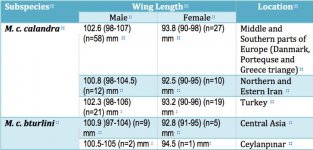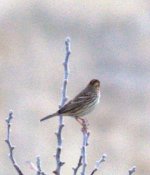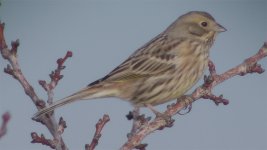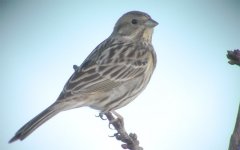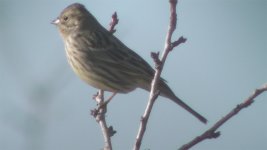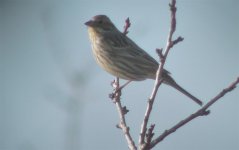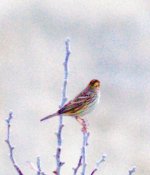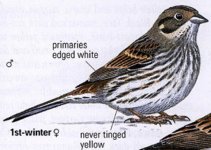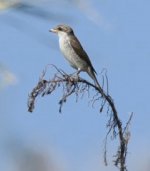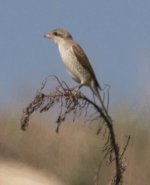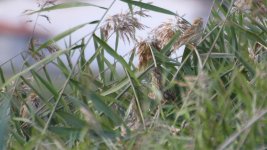-
Welcome to BirdForum, the internet's largest birding community with thousands of members from all over the world. The forums are dedicated to wild birds, birding, binoculars and equipment and all that goes with it.
Please register for an account to take part in the discussions in the forum, post your pictures in the gallery and more.
You are using an out of date browser. It may not display this or other websites correctly.
You should upgrade or use an alternative browser.
You should upgrade or use an alternative browser.
Mystery bunting - Turkey (1 Viewer)
- Thread starter alazzo
- Start date
More options
Who Replied?Rotherbirder
Well-known member

Yet another thread deteriorates into unhelpful smart*ss wisecracks. I've never seen the 'alternative language' trick before when parties disagree though. Time to bow out methinks; life is too short.
Roland,
Corn bunting is not only identified by bigger size. (The large size is not the only identification characteristic of the corn bunting) Please check the following tables (prepaired by myself): Comparing the corn buntings measured in Turkey there is a 1.6 cm wing length difference within the species itself, without taking into account the subspecies and sex differentiations but only taking into account extreme specimens. This difference is larger than the difference of the wing lengths between the smallest corn bunting and the other bunting species including the (largest specimen of the) little bunting.
Straight logic does not work always . If it would, Edith Piaf would be a Taiwanese lady, and Venus and Serena Williams would be German. Because, their sizes do fit Aristo's "reductio ad absurdum" works in many cases, but not in birding. Joining in birdforum and jumping directly to the Turkish bunting discussion really surprised me, in this case I would expect, from you at least a discussion about the bill size measurements of the European corn buntings that you mentioned should be big. Hint: there was a study, pressed by "Deutsches Ornithologische Geselscaft" at the end of eighties. You can kindly share some information from there with us.
Aristo's "reductio ad absurdum" works in many cases, but not in birding. Joining in birdforum and jumping directly to the Turkish bunting discussion really surprised me, in this case I would expect, from you at least a discussion about the bill size measurements of the European corn buntings that you mentioned should be big. Hint: there was a study, pressed by "Deutsches Ornithologische Geselscaft" at the end of eighties. You can kindly share some information from there with us.
Ebird lovers,
I've seen this movie before. Take an unclear photo or an unproved bird count, write to a couple of international forums. Then find two British and one or two Dutch/French guy who support the claimed bird. Collect the writings and show on Turkish websites. After all a new species to Turkish and/or local fauna is welcomed. Use it for some planned purposes. Can somebody look back to two-three years for how many times this happened. And check if the starters of the discussions and the supporters are same, related or not? Instead of discussing and learning birds, making such gasbagging is not a good thing. This reminds me the "how to write an Anatolian Rock songpiece" formula describe by infamous Turkish standup maker Cem Yılmaz.
Back to the subject bird; can anyone comment about the erythrogenys subspecies of Emberiza citrinella, which found in Turkey, especially in this season
Murat F. Özçelik
https://vimeo.com/channels/murat
Corn bunting is not only identified by bigger size. (The large size is not the only identification characteristic of the corn bunting) Please check the following tables (prepaired by myself): Comparing the corn buntings measured in Turkey there is a 1.6 cm wing length difference within the species itself, without taking into account the subspecies and sex differentiations but only taking into account extreme specimens. This difference is larger than the difference of the wing lengths between the smallest corn bunting and the other bunting species including the (largest specimen of the) little bunting.
Straight logic does not work always . If it would, Edith Piaf would be a Taiwanese lady, and Venus and Serena Williams would be German. Because, their sizes do fit
Ebird lovers,
I've seen this movie before. Take an unclear photo or an unproved bird count, write to a couple of international forums. Then find two British and one or two Dutch/French guy who support the claimed bird. Collect the writings and show on Turkish websites. After all a new species to Turkish and/or local fauna is welcomed. Use it for some planned purposes. Can somebody look back to two-three years for how many times this happened. And check if the starters of the discussions and the supporters are same, related or not? Instead of discussing and learning birds, making such gasbagging is not a good thing. This reminds me the "how to write an Anatolian Rock songpiece" formula describe by infamous Turkish standup maker Cem Yılmaz.
Back to the subject bird; can anyone comment about the erythrogenys subspecies of Emberiza citrinella, which found in Turkey, especially in this season
Murat F. Özçelik
https://vimeo.com/channels/murat
Attachments
Jane Turner
Well-known member
Regardless of what can be seen in the photo, claiming a safe record of vagrant when the single most helpful feature for ruling out all but Chestnut Bunting and Yellowhammer (the rump) was not seen well enough to say what colour it was, seems to be folly.
Jane Turner
Well-known member
Back to the subject bird; can anyone comment about the erythrogenys subspecies of Emberiza citrinella, which found in Turkey, especially in this season
Murat F. Özçelik
https://vimeo.com/channels/murat
I hadn't appreciated just how grey-toned they were
http://www.birds.kz/taxons/561/fronpic2.jpg
It not liking that - try this
http://www.birds.kz/v2taxon.php?s=561&l=en
Same attitude with blyth's reed warbler discussion. First a bad photo then better prompting photos  here are some of my video framegrabs which are taken in 5km diameter of where the "mysterious bird" photos were taken. Anyone who interested in, can equalize the colorimetric values with uploded photos and compare the birds side by side. I can find a nape pose if I can scan my several hours of bunting videos. But I won't. Because I believe whoever reads the "Handbook of Western Palearctic" or even Roselaar 95 can judge and identify the bird easily.
here are some of my video framegrabs which are taken in 5km diameter of where the "mysterious bird" photos were taken. Anyone who interested in, can equalize the colorimetric values with uploded photos and compare the birds side by side. I can find a nape pose if I can scan my several hours of bunting videos. But I won't. Because I believe whoever reads the "Handbook of Western Palearctic" or even Roselaar 95 can judge and identify the bird easily.
Even looking at the movements of the acclaimed birds can indicate wheather it is the mentioned vagrant species or not. The illegal birdcatchers/sellers at Ulus-Ankara know well when and to where these vagrants arrives here. In the past, I fought of them alot to recue birds. When I heard about the "mysterious" vagrant species I mentioned it to one of my recortmen "Birds of Turkey" photographer friend, and he smiled and said "it is too early for that one"..
Please also check these studies:
https://aulaenred.ibercaja.es/wp-content/uploads/444_Emberiza_citrinella.pdf
http://aulaenred.ibercaja.es/wp-content/uploads/454_CornBuntingM.calandra.pdf
Murat F. Özçelik
https://vimeo.com/channels/murat
Even looking at the movements of the acclaimed birds can indicate wheather it is the mentioned vagrant species or not. The illegal birdcatchers/sellers at Ulus-Ankara know well when and to where these vagrants arrives here. In the past, I fought of them alot to recue birds. When I heard about the "mysterious" vagrant species I mentioned it to one of my recortmen "Birds of Turkey" photographer friend, and he smiled and said "it is too early for that one"..
Please also check these studies:
https://aulaenred.ibercaja.es/wp-content/uploads/444_Emberiza_citrinella.pdf
http://aulaenred.ibercaja.es/wp-content/uploads/454_CornBuntingM.calandra.pdf
Murat F. Özçelik
https://vimeo.com/channels/murat
Attachments
kuzeycem
Medicinal Birding

Same attitude with blyth's reed warbler discussion. First a bad photo then better prompting photoshere are some of my video framegrabs which are taken in 5km diameter of where the "mysterious bird" photos were taken. Anyone who interested in, can equalize the colorimetric values with uploded photos and compare the birds side by side. I can find a nape pose if I can scan my several hours of bunting videos. But I won't. Because I believe whoever reads the "Handbook of Western Palearctic" or even Roselaar 95 can judge and identify the bird easily.
Even looking at the movements of the acclaimed birds can indicate wheather it is the mentioned vagrant species or not. The illegal birdcatchers/sellers at Ulus-Ankara know well when and to where these vagrants arrives here. In the past, I fought of them alot to recue birds. When I heard about the "mysterious" vagrant species I mentioned it to one of my recortmen "Birds of Turkey" photographer friend, and he smiled and said "it is too early for that one"..
Please also check these studies:
https://aulaenred.ibercaja.es/wp-content/uploads/444_Emberiza_citrinella.pdf
http://aulaenred.ibercaja.es/wp-content/uploads/454_CornBuntingM.calandra.pdf
Murat F. Özçelik
https://vimeo.com/channels/murat
Primary edges look yellow on these birds. Also they have yellow on face and supercilia. Pretty sure they're Yellowhammers.
Last edited:
Of course they are Yellow Buntings. I was expecting subspecies level descriptions and similarities/differences with the mentioned bird. If someone claims a bird is a vagrant/rare bird, I believe should know and compare depending on the bird topography. But these (Turkey specific) information are not present in 20 USD guidebooks or on Mr. Google. I am addressing the sources and when claimants look at there will see where they fail. On the other hand instead of looking at the pictures I shared and comparing similarities with the claimed bird pictures, only identifying the pictures I shared and considering weather it is vagrant or not, is an interesting approach. For doing this, I mean seeing the yellowish cast clearly, someone should boost up or saturate the color value. But I suggested "equalizing colorimetric values" and comparing the birds.
Mr MacNara suggested increasing the contrast and draw our attention to the patterns of the bird. Mr. Roland suggested to look at the size of the bird. And MS Jane Turner pointed out the color as an ID critter, is hidden in two photos.
I follow a basic approach when I see the first photo. Since I know the behaviour of the cmos chip and canikon software, I just boost the colors on my IPad (I didn't even open my mac and Photoshop). And immediately noticed the yellow cast on the birds rear flanks. Then I prepared color corrected/increased picture together with the illustration/explanation. But holy EBird approved the claimed bird as a "pine bunting". I don't know any, any scientific information that a pine bunting has yellowish cast on the flanks, regardless of the age/sex. Perhaps I have to learn something more about pine bunting from "St. EBird approvers".
There are more complex analyzing methods: use a forensic software. But before that, the data readout capacity of the chip should be known. This information never writes on the camera manufacturer sites or cameras user manuals. Agreements on camera manufacturer and CMOS manufacturer should be read from appropriate forums or patent institutes. Then cameras internal electronics should be known very well (data bus speed etc.). A professional astronomy software can help to regulate atmospheric effects (ask someone from cloudynights, they may be helpful, otherwise it is an extremely expensive software ). After all bring the picture back to the forensic software to calculate and correlate the pixels with the critical areas, in this case the rump and the rear flanks of the bird. The pixel sizes of the used camera sensor should also be correlated. Then adjust the light conditions, concerning the photo exif information and/or USGS published values at that time. At that stage the realistic pixel colors and patterns can be reached. There are more "semi-steps" but no need to mention. Pardon? Is it too complex?, then never mind whatever bunting you want this to be, it will be that
In the last two photos (attached below) I am sharing one bird, shot almost simultaneously with two different camera systems (by two of my bird photographer friends). One of them was taken with Canon 100-400mm v2 lens with 7DM2 camera. And the other is Nikon D4s with Nikkor 500mm f4 lens. Please notice how the camera software algorithm effects the bird's ID. The lesser coverts recorded differently on two cameras. Again poor "St. ID approvers" decided differently.
Years ago, before digital age, in Turkey somebody was using the filter tricks to change the color of certain parts of a bird. Nowadays same thing is happening intentionally or (I believe) unintentionally (caused by camera algorithm). Today most of those people became academicians and prepares some bird survey reports BTW. Many international credit banks are using worlds best experts to evaluate the bird survey reports that are part of the the energy investment reports. Birds are one of the important parts of these reports. Anyone who is interested in, can find on the internet, how many birding reports were refused by the banks . Although I am not an academician, I can proudly say that none of my reports have been so far refused.
I believe many of the ID problems in birds are caused by being a bird photographer, before being a bird observer. The beginners compare their photos with guidebooks, other photos etc., not with the images they memorize. Some bird photographers uses cheap Chinese binoculars, in addition to CMOS chipped SLRs. In my opinion these people never memorize the real color, contrast and tinges of the bird feathers which can be recognized and memorized only by using top German optics and recorded by Bayer CCD based cameras (with minimal algorithm effect). World infamous (Leica master) Ara Güler and I am getting help from same mechanic master (Okan Bayülgen and Serdar Bilgili and many good photographers also get their equipment fixed by this same person..) according to that master, when Ara Güler would take a series of pictures, he first goes to the place without any memory card (in the past, film) and works to find the best view angle for hours. Then next day he goes to the scene and makes his work in half an hour. Also I worked with many British, German and Dutch master birders. Bird photography is the least interest for most of them. I recommend to young birders before being a photographer, to become a good birder. Classifying the bird photos or commenting on them with limited information is not the right way.
Murat F. Özçelik
https://vimeo.com/channels/murat
Mr MacNara suggested increasing the contrast and draw our attention to the patterns of the bird. Mr. Roland suggested to look at the size of the bird. And MS Jane Turner pointed out the color as an ID critter, is hidden in two photos.
I follow a basic approach when I see the first photo. Since I know the behaviour of the cmos chip and canikon software, I just boost the colors on my IPad (I didn't even open my mac and Photoshop). And immediately noticed the yellow cast on the birds rear flanks. Then I prepared color corrected/increased picture together with the illustration/explanation. But holy EBird approved the claimed bird as a "pine bunting". I don't know any, any scientific information that a pine bunting has yellowish cast on the flanks, regardless of the age/sex. Perhaps I have to learn something more about pine bunting from "St. EBird approvers".
There are more complex analyzing methods: use a forensic software. But before that, the data readout capacity of the chip should be known. This information never writes on the camera manufacturer sites or cameras user manuals. Agreements on camera manufacturer and CMOS manufacturer should be read from appropriate forums or patent institutes. Then cameras internal electronics should be known very well (data bus speed etc.). A professional astronomy software can help to regulate atmospheric effects (ask someone from cloudynights, they may be helpful, otherwise it is an extremely expensive software ). After all bring the picture back to the forensic software to calculate and correlate the pixels with the critical areas, in this case the rump and the rear flanks of the bird. The pixel sizes of the used camera sensor should also be correlated. Then adjust the light conditions, concerning the photo exif information and/or USGS published values at that time. At that stage the realistic pixel colors and patterns can be reached. There are more "semi-steps" but no need to mention. Pardon? Is it too complex?, then never mind whatever bunting you want this to be, it will be that
In the last two photos (attached below) I am sharing one bird, shot almost simultaneously with two different camera systems (by two of my bird photographer friends). One of them was taken with Canon 100-400mm v2 lens with 7DM2 camera. And the other is Nikon D4s with Nikkor 500mm f4 lens. Please notice how the camera software algorithm effects the bird's ID. The lesser coverts recorded differently on two cameras. Again poor "St. ID approvers" decided differently.
Years ago, before digital age, in Turkey somebody was using the filter tricks to change the color of certain parts of a bird. Nowadays same thing is happening intentionally or (I believe) unintentionally (caused by camera algorithm). Today most of those people became academicians and prepares some bird survey reports BTW. Many international credit banks are using worlds best experts to evaluate the bird survey reports that are part of the the energy investment reports. Birds are one of the important parts of these reports. Anyone who is interested in, can find on the internet, how many birding reports were refused by the banks . Although I am not an academician, I can proudly say that none of my reports have been so far refused.
I believe many of the ID problems in birds are caused by being a bird photographer, before being a bird observer. The beginners compare their photos with guidebooks, other photos etc., not with the images they memorize. Some bird photographers uses cheap Chinese binoculars, in addition to CMOS chipped SLRs. In my opinion these people never memorize the real color, contrast and tinges of the bird feathers which can be recognized and memorized only by using top German optics and recorded by Bayer CCD based cameras (with minimal algorithm effect). World infamous (Leica master) Ara Güler and I am getting help from same mechanic master (Okan Bayülgen and Serdar Bilgili and many good photographers also get their equipment fixed by this same person..) according to that master, when Ara Güler would take a series of pictures, he first goes to the place without any memory card (in the past, film) and works to find the best view angle for hours. Then next day he goes to the scene and makes his work in half an hour. Also I worked with many British, German and Dutch master birders. Bird photography is the least interest for most of them. I recommend to young birders before being a photographer, to become a good birder. Classifying the bird photos or commenting on them with limited information is not the right way.
Murat F. Özçelik
https://vimeo.com/channels/murat
Attachments
Kaan Ozgencil
Birdwatcher and ecologist
Ebird is only as good as the person on the other end of it - in some cases a single individual who is not necessarily an expert in that particular branch of birds.
On the other hand a number of very good birders (experts even) on here have either said it isn't a Pine Bunting, or that it is a Corn Bunting ...
As a new BF member, I really don't know who the experts are here. Would you mind naming some who replied to this thread =) Thanks!
bitterntwisted
Graham Howard Shortt
As a new BF member, I really don't know who the experts are here. Would you mind naming some who replied to this thread =) Thanks!
Not me. Several of those who commented subsequently are birders with reputations, e.g. http://www.limosaholidays.co.uk/leader/Brian-Small/
Not me. Several of those who commented subsequently are birders with reputations, e.g. http://www.limosaholidays.co.uk/leader/Brian-Small/
Brian J Small is a world-class bird artist. He's the main artist for Birds of East Africa, one of the artists for Birds of East Asia, and has also worked on Handbook of Birds of the World. You can't be a bird artist of that quality without a great eye. He thinks this bird is Corn Bunting.
(The Brian Small who posts on Bird Forum is Brian J Small, bird artist of Britain, not Brian E Small, bird photographer of the US.)
dantheman
Bah humbug
+ contributing/writing various bird id papers.
There isn't actually a proper biography of persons on here, but thinking Motmot, Jane Turner, Rafael Matias are rarity committee members (National?) or material for. Others are well-travelled enough/internet id-hardened enough to know what is what. Apols if left anyone out.
Anyone can make mistakes/be misled with less-than-perfect internet images, but general principles apply.
wrt ebird - I think it is perfectly possible to query an id/get it questioned with ebird, although don't know the procedure.
There isn't actually a proper biography of persons on here, but thinking Motmot, Jane Turner, Rafael Matias are rarity committee members (National?) or material for. Others are well-travelled enough/internet id-hardened enough to know what is what. Apols if left anyone out.
Anyone can make mistakes/be misled with less-than-perfect internet images, but general principles apply.
wrt ebird - I think it is perfectly possible to query an id/get it questioned with ebird, although don't know the procedure.
Last edited:
Hi all,
I am far from as experienced with some of the species that have been mentioned on here so far as some of the contributors...for example, as Corn Bunting is sadly extinct in Ireland, I mainly only see this species when visiting a country within its extant range, and I have only seen a female Pine Bunting once, the co-operative bird at Wilhelminadorf, the Netherlands last winter...but I shall add my five cents worth.
Looking at the original image, which hasn't had the contrast enhanced, or colours changed all that much, and is possibly the closest fit to what the bird may have looked like in life, I would see a few problems for Pine Bunting. Namely, I would expect at least somewhat of a warmer/rusty wash underlying the streaking somewhere on the breast sides, with perhaps some of the streaks themselves being a warmer brown. Some typical birds would have quite an obvious rufous wash underlying the breast and flank feathers, and I'd just not expect such prominent and 'continuous' breast and flank streaking on a Pine Bunting. The bird also seems a bit more streaked than one would expect for a Yellowhammer, and I can't see any yellow tones to the fringes of the remiges, though I concede that erythrogenys could look greyer, as already stated by Murat.
The bill shape, despite the rather 'unfair' comparison shot showing a heavily pixellated crop of the subject bird next to a sharp image of a Corn Bunting, doesn't quite seem right for a Pine Bunting or Yellowhammer to me, but, that said, I'd much prefer to base this 'hunch' on more solid evidence.
The median coverts have obviously white or whitish tips, which is a bit worrying for Pine Bunting or Yellowhammer, but fine for Corn Bunting. Again, I concede that perhaps the poor image quality could be influencing the apparent colour, but it really does seem whitish, and there's also a faint but apparent whitish wingbar former by pale tips to the greater coverts, or seems to be anyway.
I think that the uppertail coverts that are just about visible in this image don't look rufous enough for Pine Bunting or Yellowhammer, but I could be wrong. Also, the nape is usually paler and greyer than this on a female Pine Bunting. The apparent orange tones to the leg colour do remind me of those often seen on Corn Bunting. Finally, and this is just a wild hunch based on a perhaps flawed reading of some poor images, the subject bird doesn't seem to have the typical Emberiza tertial pattern whereby the dark centres narrow abruptly towards the feather tips, producing a 'stepped' effect. Some buntings have more regular dark centres without such a step, Corn Bunting being one of them.
That said, I am more than prepared to listen to a constructive case for this being anything else. As I said, I don't see Corn Buntings very often, but that is what I think this most likely is.
Regards,
Harry
I am far from as experienced with some of the species that have been mentioned on here so far as some of the contributors...for example, as Corn Bunting is sadly extinct in Ireland, I mainly only see this species when visiting a country within its extant range, and I have only seen a female Pine Bunting once, the co-operative bird at Wilhelminadorf, the Netherlands last winter...but I shall add my five cents worth.
Looking at the original image, which hasn't had the contrast enhanced, or colours changed all that much, and is possibly the closest fit to what the bird may have looked like in life, I would see a few problems for Pine Bunting. Namely, I would expect at least somewhat of a warmer/rusty wash underlying the streaking somewhere on the breast sides, with perhaps some of the streaks themselves being a warmer brown. Some typical birds would have quite an obvious rufous wash underlying the breast and flank feathers, and I'd just not expect such prominent and 'continuous' breast and flank streaking on a Pine Bunting. The bird also seems a bit more streaked than one would expect for a Yellowhammer, and I can't see any yellow tones to the fringes of the remiges, though I concede that erythrogenys could look greyer, as already stated by Murat.
The bill shape, despite the rather 'unfair' comparison shot showing a heavily pixellated crop of the subject bird next to a sharp image of a Corn Bunting, doesn't quite seem right for a Pine Bunting or Yellowhammer to me, but, that said, I'd much prefer to base this 'hunch' on more solid evidence.
The median coverts have obviously white or whitish tips, which is a bit worrying for Pine Bunting or Yellowhammer, but fine for Corn Bunting. Again, I concede that perhaps the poor image quality could be influencing the apparent colour, but it really does seem whitish, and there's also a faint but apparent whitish wingbar former by pale tips to the greater coverts, or seems to be anyway.
I think that the uppertail coverts that are just about visible in this image don't look rufous enough for Pine Bunting or Yellowhammer, but I could be wrong. Also, the nape is usually paler and greyer than this on a female Pine Bunting. The apparent orange tones to the leg colour do remind me of those often seen on Corn Bunting. Finally, and this is just a wild hunch based on a perhaps flawed reading of some poor images, the subject bird doesn't seem to have the typical Emberiza tertial pattern whereby the dark centres narrow abruptly towards the feather tips, producing a 'stepped' effect. Some buntings have more regular dark centres without such a step, Corn Bunting being one of them.
That said, I am more than prepared to listen to a constructive case for this being anything else. As I said, I don't see Corn Buntings very often, but that is what I think this most likely is.
Regards,
Harry
Kaan Ozgencil
Birdwatcher and ecologist
Thank you all for helping out with the ID of the bird and introducing me some of the experienced BF members. I'm glad to finally be a BF member and get to know you people. It seems the bird is most probably a corn bunting. I send you our warmest regards from Ankara, Turkey. Have a good day!
Maffong
Well-known member
If anyone still needs to be convinced, here's a pic I took last year in Spain. The birds are 100% Corn Buntings and I can't see much difference to the discussed bird. I'd apologize for the bad quality, but I think in this case it adds to the comparability
Maffong
Maffong
Attachments
Rotherbirder
Well-known member

... I recommend to young birders before being a photographer, to become a good birder. Classifying the bird photos or commenting on them with limited information is not the right way.
Murat F. Özçelik
Finally, out of this very convoluted and often confusing thread comes some sound advice! Today, too many so-called 'birders' blast away with a camera and attempt to identify to species - or expect others to do so - afterwards and, in many cases, this won't work. Technology is no match for years in the field looking at birds!
RB
Andy Adcock
Worst person on Birdforum

Finally, out of this very convoluted and often confusing thread comes some sound advice! Today, too many so-called 'birders' blast away with a camera and attempt to identify to species - or expect others to do so - afterwards and, in many cases, this won't work. Technology is no match for years in the field looking at birds!
RB
Surely such people are photogaphers not birders?
My wife is a photographer who enjoys birding, I am a birder who enjoys the fruits of her photography which often help me to resolve an ID way after the initial sighting, high raptors especially.
We all make boo boos in the field, I make many, daily and often my wifes photographs are a great aid to learning, for me anyway and a way to resolve my 'in field' boo boos.
I agree though that this forum has a number of people who don't even try to identify birds for themselves and post sometimes dozens of shots. When I return from Costa Rica in April, I expect to be asking members for help with some pics but not until I've had a good go myself and only if the pics are to a certain standard. My wife won't let me post bad shots anyway!
A
Last edited:
Kaan Ozgencil
Birdwatcher and ecologist
I really don't understand why you people went on to classify me as a photographer rather than a birdwatcher without even knowing who I am. I've always asked questions rather than coming to conclusions in comments (and I believe I've always been kind doing so) and I surely am a young birdwatcher but I am a biologist who studied at the best university in his country and will be a good scientist and a birdwatcher one day. I should also say I don't even take photographs of birds and I had spent a full day trying to identify this bird before my friend (owner of the photo) and I uploaded the photo on BF. I hope I just mistook your comments and acted over-sensivitely. I just wanted to get the bird the right ID and learn some stuff about buntings.
Andy Adcock
Worst person on Birdforum

I really don't understand why you people went on to classify me as a photographer rather than a birdwatcher without even knowing who I am. I've always asked questions rather than coming to conclusions in comments (and I believe I've always been kind doing so) and I surely am a young birdwatcher but I am a biologist who studied at the best university in his country and will be a good scientist and a birdwatcher one day. I should also say I don't even take photographs of birds and I had spent a full day trying to identify this bird before my friend (owner of the photo) and I uploaded the photo on BF. I hope I just mistook your comments and acted over-sensivitely. I just wanted to get the bird the right ID and learn some stuff about buntings.
I don't think the comments were aimed at you personally but at the growing number of people taking pictures without looking properly at birds.
For many people, the use of a photograph is a very useful but last resort in a problematic ID.
Andy
Users who are viewing this thread
Total: 2 (members: 0, guests: 2)





